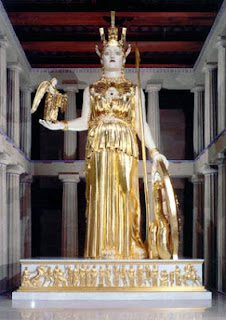The Chryselephantine Athena Parthenos
 |
| Marble replica |
While the Parthenon had been built to show the splendor of Athens and dedicate their victory over the Persians to Athena, the actual architecture of the structure was particularized around a certain item. While lost in time and never seen by the modern eye, we know that a certain forty foot sculpture did exist and lied in the center of the temple for centuries, known through the records of various historians of the time. Furthermore, we are given an idea of how the sculpture may have looked through the multiple copies constructed while the original was still in existence. This magnificent Athena Parthenos, while lost, is still considered the pinnacle of ancient art.
However, no replica could ever match the grandeur of the original. A "chryselephantine"is not a specific piece, but a style. Like many Greek styles of art, this form of sculpture was carried over from the Egypt. The style is not measured by strokes, but of material. A combination of Greek words χρυσος (pronounced "chrysos", meaning gold) and ηλεφαντινος (pronounced elephantinos, meaning ivory), the name describes the object. While this is the most famous of all chryselephantine works, to the extent that if capitalized, this one of Athena is implied, the only necessary processies for creating such a sculpture would be to create the body of the image out of ivory and put it in a "drapery of gold" (britannica.com). Unfortunately, there are no longer replicas of such a piece in its original materials, since the two are incredibly expensive and ivory now illegal to produce, being made of elephant tusks. However, this sculpture was part of the "splurge of the century". The Persian War had just ended, and the Delian League had fixed it's capital in Athens. With this shift, Athens became the most influential city state in Greece. With such victories, no material was considered to expensive or ostentatious when praising their patron goddess, especially since the entire League would be paying, over the lone government. The sculpture, along with the base, depicting Pandora's birth, are believed to have been completed by the famous sculptor and architect Phidias in 438 BCE, 8 years before his death, during the High Classical Period of art.
As most art of the ancient time, this colossal sculpture delivered a message. The majority of the population would be illiterate, so physical representations were often necessary and expected. The great size and heroic frame of the
goddess of Athens depicted supremacy over the other city states. In her right hand sits a nike, a goddess of victory, in order to remind the citizens of the great and victorious war that their ancestors had undergone. Meant to inspire citizens and please the gods who had granted them such a victory, no entity was spared and no symbol undepicted.
Her breastplate was said to have been adorned with snakes and the head of Medusa, given to her by Perseus through commonly known myth. In this along with other additions, Phidias demonstrates astounding detail, telling stories without a single syllable. The theme of victory through just warfare continues on the shield in her left hand. The outside of this shield depicts the Amazonomachy, or the war where Athenians under the legendary hero Theseus defeated the Amazons. Inside lies the Gigantomachy, when Zeus ultimately defeated the giants. In fact, as the evolution of art continues, the giants were no longer seen as human, but terrible, snake-like beasts, increasing the sensation of the man-like gods triumphing over incredible forces. A third victory is said to have been depicted on the sandals of Athena, which tell of the Centauromachy, against centaurs who had attempted to steal the bride Hippodamia on her wedding day. Theseus, again an Athenian hero, preformed yet another famous battle against an the formidable and destructive centaurs. Obviously, these battles mean to idealize the war with the Persians, stating that as powerful as they were, the Greeks were even more so. The shield of Athena is covering a snake, which while relative to the myth of Ericthronius, also seems to be a promise to the Greeks that Athena would protect them from any danger to come. Obviously propaganda, this piece is still magnificent. A tragic loss, its beauty was clearly so great that others had to make replicas, which are atleast a looking glass into this amazing past.
As most art of the ancient time, this colossal sculpture delivered a message. The majority of the population would be illiterate, so physical representations were often necessary and expected. The great size and heroic frame of the
goddess of Athens depicted supremacy over the other city states. In her right hand sits a nike, a goddess of victory, in order to remind the citizens of the great and victorious war that their ancestors had undergone. Meant to inspire citizens and please the gods who had granted them such a victory, no entity was spared and no symbol undepicted.
 |
| Replica denoting appearance |




